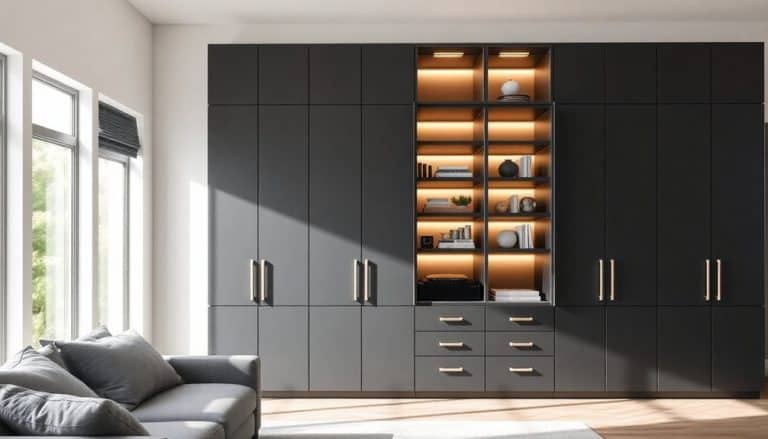This website contains affiliate links. Some products are gifted by the brand to test. As an Amazon Associate, I earn from qualifying purchases. The content on this website was created with the help of AI.
You can maximize your small apartment’s space through strategic organization techniques that work vertically and horizontally. Start by utilizing wall height with floating shelves above doorways and windows, then incorporate multi-purpose furniture like storage ottomans and murphy beds. Transform unused spaces by installing between-stud shelving and under-bed storage containers. Optimize your closets with double hanging rods and slim velvet hangers, while using wall-mounted solutions like fold-down desks and magnetic strips to free up floor space. These smart storage solutions are just the beginning of your space-saving transformation.
Key Takeaways
- Maximize vertical space with floor-to-ceiling bookcases and floating shelves above doorways, windows, and high-traffic areas.
- Select multi-functional furniture like murphy beds with desks, storage ottomans, and expandable dining tables to serve multiple purposes.
- Install double hanging rods and use slim velvet hangers in closets to double clothing storage capacity.
- Utilize hidden storage opportunities beneath beds, behind doors, and between wall studs for clutter-free organization.
- Choose mobile furniture pieces like rolling kitchen islands and modular storage units for flexible space optimization.
Vertical Storage Hacks

When space is limited in your small apartment, vertical storage solutions offer untapped potential by utilizing wall height instead of precious floor space. You’ll find numerous opportunities to maximize storage by thinking upward rather than outward, from floor to ceiling.
Install floating shelves in strategic locations, such as above doorways, windows, and toilets. Stack them at varying heights to create visual interest while storing books, decorative items, or bathroom essentials. Mount pegboards in your kitchen or home office to hang tools, utensils, or office supplies, keeping them visible yet organized.
Consider installing floor-to-ceiling bookcases or modular storage units that maximize vertical space. Use over-the-door organizers for shoes, accessories, or cleaning supplies. Install hooks and rails on walls to hang bikes, sports equipment, or cooking tools. Add shelf risers inside kitchen cabinets to double your storage capacity.
Don’t forget unused corners – install corner shelving units that stretch from floor to ceiling. Use tension rods in closets to create additional hanging space, and invest in stackable storage containers that can be arranged vertically when not in use. For bathroom drawers and cabinets, choose BPA-free plastic organizers that resist humidity and maintain their clarity over time.
Multi-Purpose Furniture Solutions
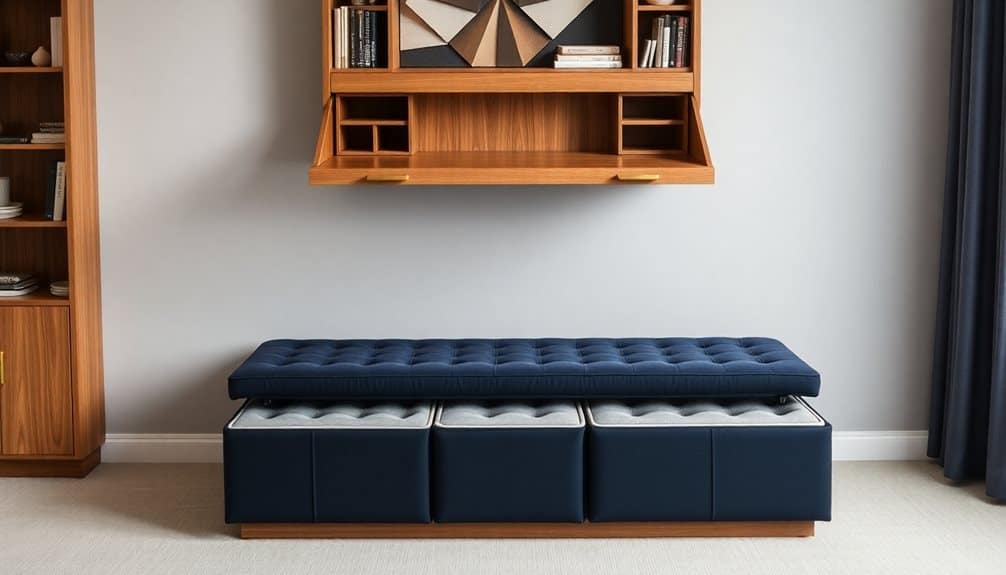
A small apartment’s best allies are furniture pieces that serve multiple functions. You’ll maximize your limited space by selecting items that can transform to serve different purposes throughout the day. Consider investing in a murphy bed that folds into a desk or a coffee table that converts into a dining surface for four people.
Storage ottomans offer dual functionality as both seating and hidden compartments for blankets, magazines, or gaming accessories. You can opt for modular sofas with built-in storage underneath the cushions, or choose expandable dining tables that collapse when not in use. Nesting tables provide flexible surface areas that you can spread out during parties and stack away when you need floor space.
For your bedroom, consider a bed frame with built-in drawers underneath, eliminating the need for a separate dresser. Install a wall-mounted desk that folds flat against the wall when not in use, or select a console table that expands into a full workspace. Look for kitchen islands on wheels that can serve as both prep space and a breakfast bar, then roll away when you need more room. Modern storage headboards with integrated USB ports and shelving can eliminate the need for bedside tables while providing convenient charging solutions.
Hidden Storage Opportunities
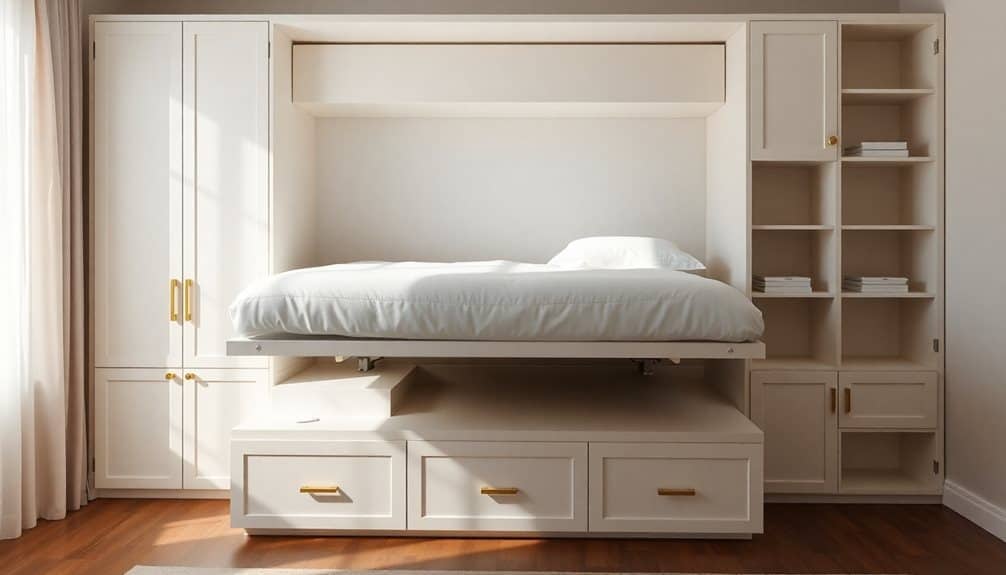
Small spaces conceal countless storage possibilities that often go unnoticed. You’ll find valuable storage real estate in unexpected places, from hollow ottomans to the dead space beneath your stairs. By thinking vertically and examining overlooked nooks, you can reveal your apartment’s hidden potential.
To maximize your space, consider these clever storage opportunities:
- Install floating shelves between wall studs to create recessed storage for books, toiletries, or spices – this technique adds storage without consuming floor space
- Utilize the space under your bed with rolling storage containers or custom-built drawers, perfect for seasonal clothing, extra linens, or rarely used items
- Transform the backs of doors with over-door organizers or custom-built shallow cabinets, ideal for shoes, accessories, or pantry items
- Convert the void space between kitchen cabinets and the ceiling into pull-down storage units for holiday decorations or occasional-use appliances
Remember to measure each potential storage area carefully before implementing solutions. The key is to identify spaces that aren’t serving a purpose and transform them into functional storage while maintaining your room’s visual flow. Double your closet capacity by installing closet rod extenders to create an additional hanging tier for clothes.
Smart Closet Organization
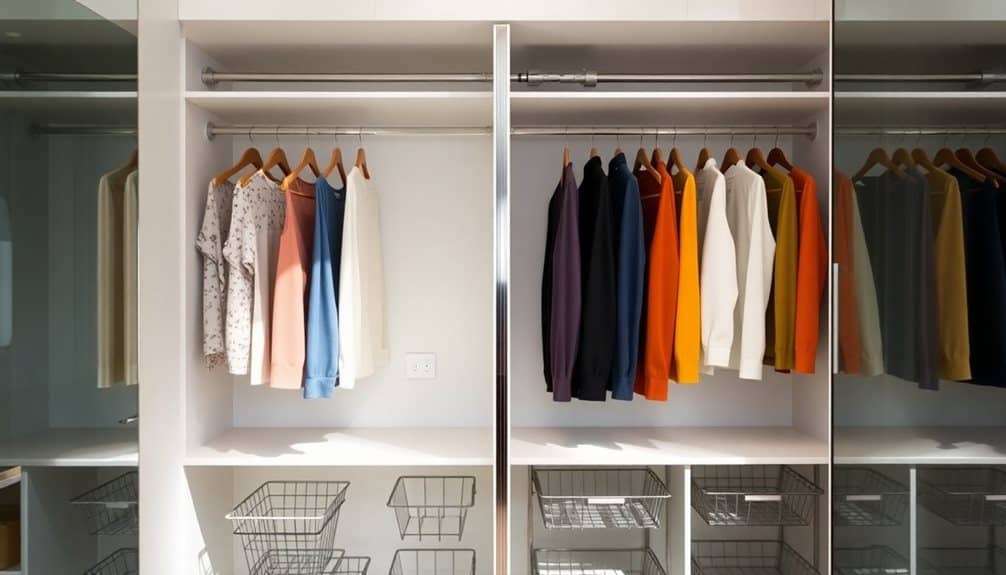
Maximizing closet space requires strategic planning and thoughtful organization to transform even the most cramped storage areas into efficient systems. Start by installing a double hanging rod to instantly double your vertical storage capacity for shorter items like shirts and folded pants. Add specialized hangers, such as cascading hooks or multi-garment organizers, to maximize horizontal space.
Divide your closet into distinct zones based on clothing type and frequency of use. Install pull-out drawers or clear storage boxes on upper shelves for seasonal items and accessories. You’ll want to use slim, velvet hangers to prevent clothes from slipping and to create uniform spacing. Add over-the-door organizers or hanging shoe racks to utilize often-overlooked vertical space.
Implement a drawer system with dividers for smaller items like socks, undergarments, and accessories. Use vacuum storage bags for bulky winter items or extra bedding when not in use. Label everything clearly and maintain a one-in-one-out policy to prevent overcrowding. Position frequently used items at eye level and store rarely used pieces in harder-to-reach spaces to optimize daily access. Consider adding a heavy-duty fabric organizer that can support up to 40 pounds of clothing while maximizing vertical storage space.
Wall-Mounted Space Savers
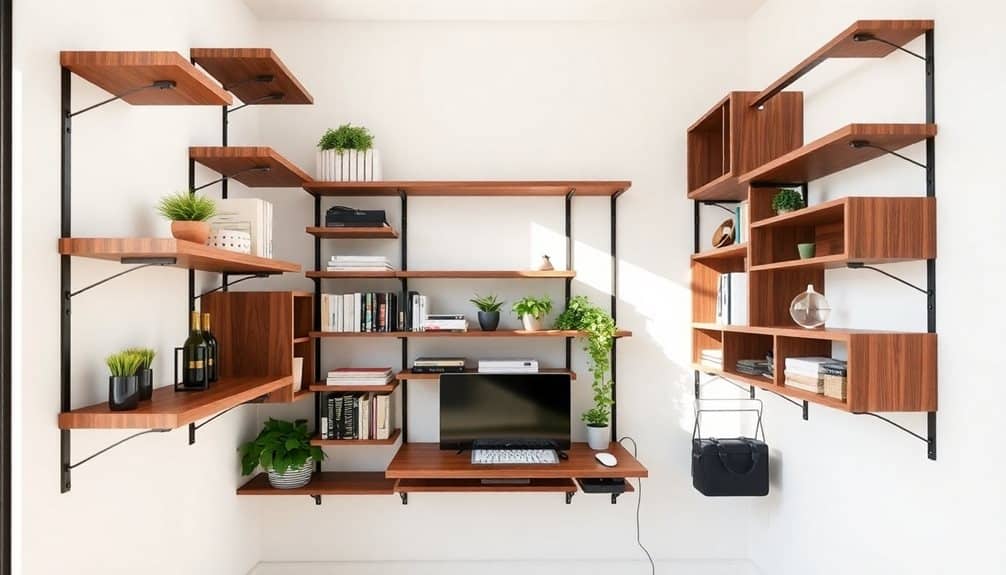
In tight living spaces, wall-mounted solutions offer invaluable storage opportunities without consuming precious floor space. You’ll find that vertical storage maximizes your apartment’s square footage while keeping essential items within easy reach. By utilizing your walls strategically, you can transform previously unused areas into functional storage zones.
Consider these practical wall-mounted solutions for your small apartment:
- Floating shelves with hidden brackets – Install them in zigzag patterns to create visual interest while storing books, photos, and decorative items. They’ll support up to 30 pounds when properly anchored.
- Fold-down desks or tables – Mount these space-saving workstations at standard desk height (30 inches) and fold them flat against the wall when not in use.
- Magnetic knife strips and utensil racks – Convert your kitchen’s wall space into an organized cooking station by mounting these metal strips at eye level.
- Adjustable track systems – Install these versatile organizers to hold everything from coat hooks to basket shelves, and easily reconfigure them as your needs change.
Remember to always check your lease agreement and use appropriate wall anchors when installing any mounted storage solutions.
Wall-mounted file organizers can transform any room into a stylish and efficient home office space.
Frequently Asked Questions
How Do I Prevent Mold Growth in Storage Spaces During Humid Seasons?
You don’t need expensive dehumidifiers to prevent mold growth. Start by keeping humidity below 60% using moisture-absorbing products like silica gel packets or DampRid containers. Place these in your storage spaces, rotate them monthly, and guarantee proper ventilation. Add cedar blocks or lavender sachets to naturally repel moisture, and use airtight plastic containers instead of cardboard boxes. Check stored items regularly for early signs of mold.
What’s the Best Way to Organize Items Shared Between Multiple Roommates?
Assign designated spaces for each roommate’s personal items, then create a clear system for shared items. You’ll need to label shelves, containers, and spaces using color-coding or name tags. Set up a digital inventory or whiteboard to track shared supplies, cleaning products, and groceries. Establish a rotation schedule for restocking and maintenance. Consider using apps like Splitwise to manage shared purchases and expenses.
Which Storage Solutions Work Best for Rental Properties With Strict Modification Rules?
You’ll find success with freestanding storage systems that don’t require wall mounting. Choose tension rods for closets, over-the-door organizers, and stackable cube storage units. Invest in furniture with built-in storage like ottoman benches or bed risers with under-bed containers. Use command hooks with removable adhesive, rolling carts, and portable wardrobe racks that you can easily take with you when moving.
How Often Should I Reorganize My Storage Systems for Maximum Efficiency?
Like a well-oiled machine, your storage system needs regular maintenance. You’ll want to assess your organization quarterly, coinciding with seasonal changes. Start by evaluating what’s working and what isn’t every three months, then make necessary adjustments. During these reviews, you should purge unused items, redistribute frequently used ones to prime locations, and reconfigure spaces that aren’t functioning efficiently. It’s best to track usage patterns monthly.
What Organization Methods Help Keep Children’s Items Accessible yet Tidy?
Use low-height storage bins labeled with pictures for young children and text for older ones. You’ll want to install hooks at kid-level height for backpacks and jackets. Set up a rotating toy system where you’ll store excess toys away, swapping them monthly to maintain novelty. Create designated cleanup zones with color-coded baskets, and establish a daily “tidy time” routine that makes organizing feel like a game.


